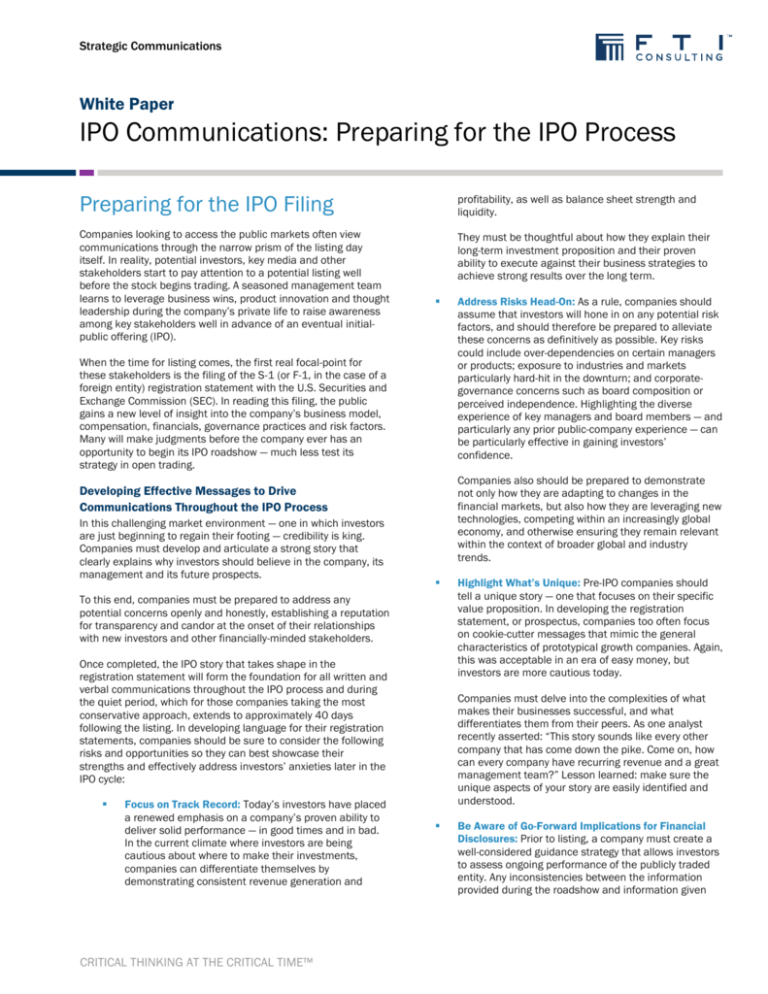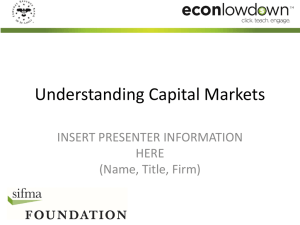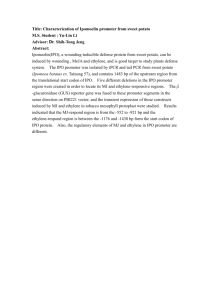
Strategic Communications
White Paper
IPO Communications: Preparing for the IPO Process
Preparing for the IPO Filing
profitability, as well as balance sheet strength and
liquidity.
Companies looking to access the public markets often view
communications through the narrow prism of the listing day
itself. In reality, potential investors, key media and other
stakeholders start to pay attention to a potential listing well
before the stock begins trading. A seasoned management team
learns to leverage business wins, product innovation and thought
leadership during the company’s private life to raise awareness
among key stakeholders well in advance of an eventual initialpublic offering (IPO).
They must be thoughtful about how they explain their
long-term investment proposition and their proven
ability to execute against their business strategies to
achieve strong results over the long term.
When the time for listing comes, the first real focal-point for
these stakeholders is the filing of the S-1 (or F-1, in the case of a
foreign entity) registration statement with the U.S. Securities and
Exchange Commission (SEC). In reading this filing, the public
gains a new level of insight into the company’s business model,
compensation, financials, governance practices and risk factors.
Many will make judgments before the company ever has an
opportunity to begin its IPO roadshow — much less test its
strategy in open trading.
Companies also should be prepared to demonstrate
not only how they are adapting to changes in the
financial markets, but also how they are leveraging new
technologies, competing within an increasingly global
economy, and otherwise ensuring they remain relevant
within the context of broader global and industry
trends.
Developing Effective Messages to Drive
Communications Throughout the IPO Process
In this challenging market environment — one in which investors
are just beginning to regain their footing — credibility is king.
Companies must develop and articulate a strong story that
clearly explains why investors should believe in the company, its
management and its future prospects.
To this end, companies must be prepared to address any
potential concerns openly and honestly, establishing a reputation
for transparency and candor at the onset of their relationships
with new investors and other financially-minded stakeholders.
Once completed, the IPO story that takes shape in the
registration statement will form the foundation for all written and
verbal communications throughout the IPO process and during
the quiet period, which for those companies taking the most
conservative approach, extends to approximately 40 days
following the listing. In developing language for their registration
statements, companies should be sure to consider the following
risks and opportunities so they can best showcase their
strengths and effectively address investors’ anxieties later in the
IPO cycle:
Focus on Track Record: Today’s investors have placed
a renewed emphasis on a company’s proven ability to
deliver solid performance — in good times and in bad.
In the current climate where investors are being
cautious about where to make their investments,
companies can differentiate themselves by
demonstrating consistent revenue generation and
CRITICAL THINKING AT THE CRITICAL TIME™
Address Risks Head-On: As a rule, companies should
assume that investors will hone in on any potential risk
factors, and should therefore be prepared to alleviate
these concerns as definitively as possible. Key risks
could include over-dependencies on certain managers
or products; exposure to industries and markets
particularly hard-hit in the downturn; and corporategovernance concerns such as board composition or
perceived independence. Highlighting the diverse
experience of key managers and board members — and
particularly any prior public-company experience — can
be particularly effective in gaining investors’
confidence.
Highlight What’s Unique: Pre-IPO companies should
tell a unique story — one that focuses on their specific
value proposition. In developing the registration
statement, or prospectus, companies too often focus
on cookie-cutter messages that mimic the general
characteristics of prototypical growth companies. Again,
this was acceptable in an era of easy money, but
investors are more cautious today.
Companies must delve into the complexities of what
makes their businesses successful, and what
differentiates them from their peers. As one analyst
recently asserted: “This story sounds like every other
company that has come down the pike. Come on, how
can every company have recurring revenue and a great
management team?” Lesson learned: make sure the
unique aspects of your story are easily identified and
understood.
Be Aware of Go-Forward Implications for Financial
Disclosures: Prior to listing, a company must create a
well-considered guidance strategy that allows investors
to assess ongoing performance of the publicly traded
entity. Any inconsistencies between the information
provided during the roadshow and information given
White Paper IPO Communications: Preparing for the IPO Process
during the first earnings announcement will call into
question both the company’s actual performance and
the management team’s ability to project its operating
performance. Furthermore, pulling guidance promised
during the roadshow can have a lasting impact on a
company’s credibility.
Be Sensitive to Use of Proceeds Implications: Use of
proceeds emerged as a key point of contention near
the end of the last up cycle, as founders (particularly
those of the big investment firms) took home hefty
profits rather than reinvesting in their companies. The
rich got richer in investors’ minds, and as markets
deteriorated, investors were left holding shares worth a
mere fraction of what founders made when they took
their companies public.
The scrutiny continues in today’s environment, where
skittish investors prefer to see profits reinvested in the
newly public company to bolster its go-forward
potential. When profits are instead going to a founder
or a private-equity firm, communicators should be
prepared with strong messages about these parties’
prior contributions to the company’s success and how
exposed their personal holdings remain to the
company’s future performance.
Establishing a Solid and Consistent Communications
Baseline
From the time the IPO is filed through the post-IPO quiet period,
companies are prevented from disclosing information beyond
what is customary and usual, including changes in the way
information is presented or in the frequency of communications.
It is important for communicators to ensure they are executing
effectively on all programs before this period begins.
As the company refines its story for the IPO registration
statement, it also should review existing communications and
train key communicators to ensure the company is conveying a
consistent message across all communications channels.
Investors and journalists often check a number of sources when
conducting due diligence, and can get put off by a company that
seems to be sending conflicting messages.
A careful review of all marketing and media materials (e.g.,
blogs, executive biographies, fact sheets, newsletters, press
releases, websites) may reveal that additional enhancements
and more consistent disclosure are needed before the IPO is
filed. With social media sites such as Facebook, Twitter and
YouTube increasingly being used as search engines,
management also needs to monitor employee activity during the
communications review process.
To mitigate the risk of unplanned disclosures, IPO prospects
must build proper investor and media relations infrastructures
CRITICAL THINKING AT THE CRITICAL TIME™
before emerging as public companies. From the creation of an
investor relations (IR) website and investor FAQs — to the
development of a system routing incoming investor and media
inquiries, and managing these relationships — companies should
not be reacting to changes, but instead have a well-developed
program in place to appropriately manage a wide variety of
situations.
Engaging Employees in the IPO Process
IPO preparations must recognize that while a public listing can
provide many new opportunities for employees (e.g., new career
opportunities, employee stock-purchase plans), it can also be
disruptive from a cultural standpoint. To manage this transition,
companies must realign their people around their go-forward
strategies and growth prospects, while simultaneously preparing
them for new communications constraints.
Employees should be educated about the rationale for a public
listing; how the listing will benefit them; and — perhaps most
critical — what new responsibilities the company must assume as
a publicly traded entity. This is often most effectively handled
through an employee roadshow in which senior managers speak
with staff at each location as they travel for investor-roadshow
meetings.
Compliance with SEC and exchange rules needs to be a
company-wide effort, and employees must understand that even
casual comments (e.g., “I made a big sale today,” “business has
been picking up lately”) made on emerging media sites or to
outside parties can take on additional meaning for the
company’s new financially minded stakeholders.
Under the watchful eye of financial analysts; financial and
business media; investors; and regulators — employee actions
have the potential not only to affect the company’s brand,
corporate reputation and stock price; but also to subject the
company and themselves to legal liability and risk resulting from
inappropriate disclosures.
All communicators — employee-engagement, IR and mediarelations teams alike — must be intimately familiar with the S-1
messages, and receive additional message training to avoid
inadvertent mistakes through the IPO period. Moreover, the
communicators must be familiar with the new regulations that
will govern their lives as part of a newly public company,
understanding the implications of disclosing non-public
information under Reg FD (Regulation Fair Disclosure).
Management should also put in place an employee disclosure
policy, and train all employees on requirements and implications
of Reg FD to help avoid violations. The SEC has signaled that it
will take into consideration whether a company conducted Reg
FD training and instituted a policy when they evaluate
wrongdoing in situations where a violation has occurred.
White Paper IPO Communications: Preparing for the IPO Process
The IPO Process
Preparation
and Filing
Assess
strengths
and
weaknesses
Life as a
Public
Company
Roadshow
and Listing
Identify
investors
Determine
peer group
Develop key
messages
Create
collateral
materials
Engage
employees
of the IPO, enhancing the initial shareholder base and reducing
volatility post-IPO.
Establish IR
and PR
infrastructure
Allocate
shares
Prepare for
earnings
Issue press
release
Conduct
perception
study
Initiate sellside outreach
to expand
coverage
Participate in
stockexchange
activities
Take control
of media
story
Meet with
analysts and
investors
Roadshow and Listing
Persuading long-term investors to believe in an untested — and
thus, inherently more risky — newly public company requires not
only a strong investment story, but also sustained, consistent
communications. Portfolio companies and fund managers need
to meet with management earlier in the process, so investors
can gain a better understanding of the company, and ultimately
show a willingness to invest.
While management teams choose banking leads based, in part,
on their ability to identify the right institutions and contacts for
their investment story; it also is important for companies to play
an active role in determining which investors should own the
stock, and how much should be allocated to each (i.e., the potallocation process).
While involving some higher-turnover funds helps drive
reasonable trading volume, smaller hedge funds (i.e., those with
less than a few hundred million in equity assets under
management) are most likely short-term investors. The impact of
this group should be counterbalanced with longer-term players
with a track record of holding stock — and potentially buying
more.
Prior to the pot-allocation process, a long-term focused
management team works with its banking leads to prioritize
meetings with long-term investors, making certain that high-profit
hedge funds do not dominate the roadshow’s participation mix.
Ensuring that many of the top long-term investors in each city are
included on the bankers’ roadshow outreach list can
dramatically enhance the quality of the firms requesting shares
CRITICAL THINKING AT THE CRITICAL TIME™
From a media perspective, heightened media attention
combined with increasing levels of investor scrutiny, eliminates
companies’ option to fly under the radar on the day their shares
begin trading. For better or worse, listing entities have greater
attention placed on them in today’s market, following a multiyear low in IPO activity. In most instances, it is advisable for
companies to seize the opportunity to take control of their own
messaging. Yet many companies remain hesitant to engage with
the media, given the inherent challenges in establishing
valuation in the market.
The gap between valuations expected by companies and
investors is widening (EY Global IPO Trends Report), and external
events have the ability to dramatically alter not only the listing
price, but also the stock’s performance in the first day of trading.
This uncertainty — and the erroneous belief that they can avoid
negative coverage by avoiding an interview — leads many
companies to shy away from media interviews.
In reality, select listing-day media interviews, conducted within
the boundaries of SEC quiet-period regulations, can help balance
potentially negative coverage with messages about the newly
listed company’s long-term strategy and investment rationale —
or embed additional key messages within already positive
stories. The key is to be ready for the various outcomes that may
result from initial trading by creating a comprehensive Q&A and
scenario plan that anticipates and addresses the potential
concerns of all key audiences.
Investors understand that a growing company’s management will
face a number of hurdles. Acknowledging that challenges exist,
and addressing them with a well thought-out action plan can
transform a potentially negative situation into an opportunity to
build long-term credibility.
White Paper IPO Communications: Preparing for the IPO Process
Beginning Life as a Public
Company
Even after the listing, a newly public company remains in a quiet
period for several weeks. Nevertheless, its IR team must be fully
engaged to complete investor targeting; develop strategy for
investor marketing; arrange and prepare for upcoming analyst
meetings and investor conferences; and get ready for the
company’s first quarterly earnings announcement.
Having a strong infrastructure in place ensures a newly public
company is talking to the right people at each of the initial
milestones, and gaining credibility with each interaction.
Earnings
The quarterly earnings announcement presents a particular
challenge for many newly public companies reporting results for
the first time while still in a quiet period. Disclosure requirements
can be met through a standalone SEC filing; but many
companies choose to be more proactive, issuing a press release
and/or hosting an analyst call in line with how they expect going
forward to communicate earnings.
Guidance
Guidance policies should be clearly established at the time of the
IPO filing, but analyst expectations must also be monitored on an
ongoing basis. Results or guidance outside the anticipated range
— be it on the upside or the downside — can significantly impair
management credibility for effectively communicating with Wall
Street, and potentially lead to a misperception that the
company’s results will be volatile.
While many companies mistakenly believe that earnings that
beat expectations will propel their stock price forward, the
benefits are often short-lived. As the stock hits more momentumbased screens, encouraging shorter-term investors to make big
bets on the company’s ability to beat Wall Street estimates,
rather than focusing on the long-term strategy.
Investor and Analyst Meetings
Even under the best conditions, management cannot meet with
all the best firms and the best contacts in any one conference or
roadshow. As IR teams work to establish the meeting schedule
for the period immediately after the IPO quiet period is lifted, the
priority should be underweighted to current investors and on-thefence targets that did not buy at the offering.
These targets should then be supplemented with appropriate
long-term investors that did not participate in the roadshow.
Building these relationships creates a new level of potential
buyers of the stock when bridge institutions or insiders want to
sell their shares.
Corporate Governance
Well-reputed investment firms will only buy into companies that
are compliant and have robust corporate-governance
infrastructures. Initial flashpoints will occur around key
disclosures and around any milestones in building an
independent, highly qualified board of directors (if one does not
exist prior to the listing). Management must work with its
communications, financial and legal advisers to ensure the
company is adapting to regulatory changes.
Benchmarking and Disclosure
Following the first earnings period, a newly public company
should conduct a realistic assessment of its investor base — as
well as the new media covering the company from a financial
point-of-view — to take a temperature check of the market’s
understanding and confidence in its value drivers, and to identify
any misconceptions about the business.
Based on this analysis, companies have the opportunity to refine
messages for subsequent conferences and investor meetings,
and consider additional disclosures for subsequent earnings
periods.
Conclusion
Even as newly public companies work to strengthen the IR
function, media-relations programs must expand to include a
new universe of reporters and publications that will cover the
company’s stock, and internal communications programs must
adapt to new regulatory issues and employee concerns.
IPOs are a corporate capital markets milestone that must be
carefully managed in order to ensure the company is a success
at the time of listing and in the aftermarket. Companies must
avoid the temptation to focus solely on the end result of a listing
(i.e., the market reception to the newly listed shares). The proper
preparation for a successful listing and a successful start as a
newly public company begins well in advance of when the shares
start trading.
An IPO is a complex process that requires careful planning and
consideration. The plan that takes into account the different
phases of an IPO; addresses all of the critical audiences; and
establishes the necessary infrastructure for a fulsome IR
program, is the right formula for a successful offering — in any
market.
For more IPO communications insights, visit
http://fticonsulting.com/ipocommunications.
Elizabeth Saunders
Americas Chairman
Strategic Communications
Tel: +1 312 553 6737
elizabeth.saunders@fticonsulting.com
CRITICAL THINKING
AT THE CRITICAL TIME™
About FTI Consulting
FTI Consulting, Inc. is a global business advisory firm dedicated to helping organizations protect and enhance enterprise value
in an increasingly complex legal, regulatory and economic environment. FTI Consulting professionals, who are located in all
major business centers throughout the world, work closely with clients to anticipate, illuminate and overcome complex business
challenges in areas such as investigations, litigation, mergers and acquisitions, regulatory issues, reputation management and
restructuring.
www.fticonsulting.com
©2014 FTI Consulting, Inc. All rights reserved.








